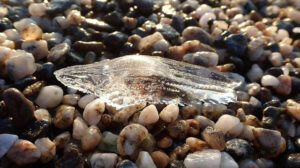A stunning dress, a carriage and a shiny pair of crystal slippers. These are the magical gifts that Cinderella receives from her fairy godmother in Charles Perot’s fairy tale of the same name, inspired by the tales of Janbatista Basile. The girl enjoys the palace ball and meets the Prince, who is enchanted by her beauty. Just before midnight, she runs to catch up before the spell is broken and loses one of the two slippers. Determined to find the stranger who has stolen his heart, the prince seeks her out by trying the slipper on all the women in the kingdom. Despite the efforts of her evil sisters to put it on, it only fits the beautiful Cinderella, whom the prince eventually marries.
The crystal slippers may have returned to their owner, but if you are very lucky it is not unlikely that you will come across some yourself, however in this case you should not follow the prince’s example, but should leave them where you found them.
Cymbulia peronii are none other than gastropods, one of the mollusc homoextracts, which usually live at depths of 150-600 meters, are elongated in shape, transparent and easily mistaken for glass. Their distinctive sculpture-like form is reminiscent of a shoe, hence their more common name of “Cinderella’s shoe” or “Aphrodite’s shoe.”
These small marine creatures up to 6 cm long are found in the Mediterranean and along the Atlantic coast, in areas with stable temperatures and stable environmental conditions.
However, in recent months they have been found on the coast of Italy, arousing the interest of bathers who initially thought it was a species of jellyfish.
As marine biologists explain, these molluscs initially carry a shell, which they lose during the transition from the larval to the adult stage, developing in its place a cartilage structure, the so-called pseudogill, which is very light and transparent. In addition, they have fins with which they are able to swim with ease and for this reason they are called sea butterflies. Thanks to their transparent body, they camouflage themselves in the marine environment and escape from predators.
And according to Joyce Andringa from the Natural History Museum in Leiden, the Netherlands, in 2022 this species was nominated in a competition for the “Mollusc of the Year”, organised annually by the Senckenberg Research Institute and the LOEWE center in Germany.
What should you do if you come across it? Nothing. Don’t pick it up and leave it where you found it, as experts say these small marine creatures are valuable to the ecosystem, as they contribute to marine biodiversity, act as indicators of habitat health, and through their decomposition contribute to the supply of nutrients for other marine creatures.
Andriga points out that in addition to their…fairy-tale appearance, they play another important role for the environment, as they manage to store carbon dioxide. As the expert explains, they produce mucus to catch their food, with this web being as much as two meters long. Once they have “feasted”, this mucus ends up on the sea floor, which on the one hand is food for other species and on the other hand retains carbon from the atmosphere.
Speaking to the Dutch Nature Today, Andriga stressed that these interesting creatures are not in danger of becoming extinct as “they have been around for millions of years, even earlier than dinosaurs. I think humans, like dinosaurs, will become extinct before these sea butterflies.”
Ask me anything
Explore related questions





